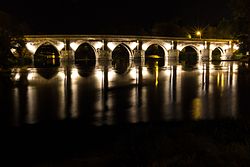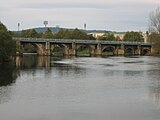
Ourense is a city and capital of the province of Ourense, located in the autonomous community of Galicia, northwestern Spain. It is on the Camino Sanabrés path of the Way of St James, and is crossed by the Miño, Barbaña, Loña and Barbañica rivers. It is also known as A cidade das Burgas due to its hot springs, being one of the European cities with the greatest thermal heritage.

Lugo is a city in northwestern Spain in the autonomous community of Galicia. It is the capital of the province of Lugo. The municipality had a population of 98,025 in 2018, making it the fourth most populous city in Galicia.

Vilalba is a municipality in Galicia (Spain), in the province of Lugo, on the left bank of the river Ladra, one of the headstreams of the Miño.

The Autovía A-54 is a freeway in Spain. It connects Santiago de Compostela with its airport with junctions onto the N-550, N-634 and Lugo via N-547.
The World Trade International Bridge is one of four international bridges located in the cities of Laredo, Texas, and Nuevo Laredo, Tamaulipas, that connect the United States and Mexico over the Rio Grande. It is owned and operated by City of Laredo and the Secretaría de Comunicaciones y Transportes. It is also known as Laredo International Bridge 4.
The Ysleta–Zaragoza International Bridge is an international crossing over the Rio Grande, connecting the United States-Mexico border cities of El Paso, Texas, and Ciudad Juárez, Chihuahua. The bridge is also known as "Zaragoza Bridge", "Puente Zaragoza" and "Puente Ysleta-Zaragoza".

The Benjamin Franklin Bridge, originally named the Delaware River Bridge and known locally as the Ben Franklin Bridge, is a suspension bridge across the Delaware River connecting Philadelphia, Pennsylvania, and Camden, New Jersey. Owned and operated by the Delaware River Port Authority, it is one of four primary vehicular bridges between Philadelphia and southern New Jersey, along with the Betsy Ross, Walt Whitman, and Tacony-Palmyra bridges. It carries Interstate 676/U.S. Route 30, pedestrians/cyclists, and the PATCO Speedline.

The San Ysidro Port of Entry is the largest land border crossing between San Diego and Tijuana, and the fourth-busiest land border crossing in the world with 70,000 northbound vehicles and 20,000 northbound pedestrians crossing each day, in addition to southbound traffic. It connects Mexican Federal Highway 1 on the Mexican side with Interstate 5 on the American side. The San Ysidro Port of Entry is one of three ports of entry in the San Diego–Tijuana metropolitan region.
The Neuquén-Cipolletti bridges are a series of four bridges that connect the cities of Neuquén and Cipolletti by spanning the Neuquén River, in Argentina. Three parallel ones, two road bridges and a railway bridge, were built on a former herd wrangling path. The fourth one was built upstream.

The Puente de Occidente, so named because it is located in western Antioquia, Colombia, is a suspension bridge that connects the municipalities of Olaya and Santa Fe de Antioquia, east and west of the Cauca River, respectively. At the time it was considered to be the third largest suspension bridge worldwide.

The Burgo Bridge(Puente del Burgo) is a medieval bridge, built over an older bridge of Roman origin, which crosses the Lérez River in the city of Pontevedra, Spain. It is on the route of the Portuguese Way to the north of the historic centre of Pontevedra and to the south of the Burgo neighbourhood. Between the arches above the pillars are carved the famous stone pilgrim's shells.

The Currents Bridge, is a tied-arch bridge that crosses the Lérez River in the city of Pontevedra, Spain. It was inaugurated in 2012 and connects Uruguay Avenue and Domingo Fontán Street.

The Tirantes Bridge is a cantilever spar cable-stayed bridge that crosses the Lérez River in the city of Pontevedra, Spain, linking the south bank to the north bank at the level of the city's Congress Hall.

The Barca Bridge is a bridge over the Lérez River, at its mouth in the Pontevedra Ria, which connects the city of Pontevedra with the municipality of Poio in Spain.

The paseo marítimo of Pontevedra is a pedestrian way along the seafront facing the ria of Pontevedra, in Pontevedra, Spain. This coastal public space is built in the urban and semi-urban area of the city and defines its encounter with the sea and the Lérez river.

The Santiago Bridge crosses the Lérez River in the city of Pontevedra (Spain), where the N-550 road runs alongside it. It connects the city centre with the A Xunqueira area and the O Burgo district.

Valdecorvos is a neighbourhood located in the eastern part of the city of Pontevedra (Spain). It is a recent residential area.

The Word Bridge is a delta-leg bridge that crosses the Lérez River in the Monte Porreiro district of the city of Pontevedra (Spain). It was inaugurated in 2011 and connects the Monte Porreiro neighbourhood with the civil parish of Lérez.


















